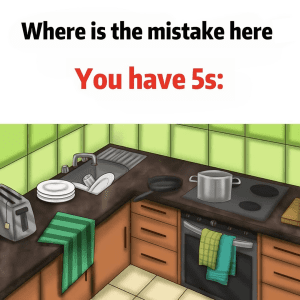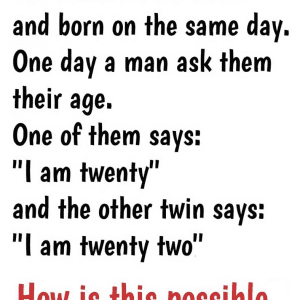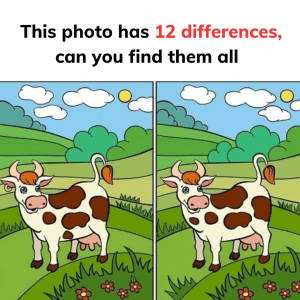Have you ever looked at an image that seemed perfectly ordinary but then noticed something strange, a detail that just didn’t belong? Today, we’re diving into a fun visual puzzle that puts your observation skills to the test. Imagine a scene where a woman is doing dishes in her kitchen. It’s a familiar setting, with dishes, utensils, and all the usual items you’d expect. But here’s the twist: there’s a subtle mistake in this scene that many people miss on the first look. Think you can spot it?
Why Our Brains Overlook Small Details in Familiar Scenes

Visual puzzles like this are designed to trick our brains by taking advantage of how we process familiar images. When we see a scene we recognize—like a kitchen—we tend to assume everything is in order. Our minds are quick to categorize familiar objects and skip over finer details. This automatic assumption helps us process information faster, but it also means we often overlook minor discrepancies unless we intentionally slow down and examine the image piece by piece.
Another reason these puzzles are challenging is that our brains focus on the whole picture rather than each element individually. We might see a woman washing dishes, utensils on the counter, and everything looks just as it should. But when we take a closer look, we notice that not everything is as it appears.
Step-by-Step Guide to Solving the Kitchen Puzzle
Let’s break down the puzzle step-by-step to uncover the hidden mistake. Follow along to see if you can solve it before reaching the answer!
1. Start with a Broad View of the Scene
Begin by taking a quick, general look at the entire image. You see a woman washing dishes with other items like a teapot, cups, and utensils around her. Everything appears normal at first, right? This initial scan helps set the scene and gives you a baseline for what looks “right” and “wrong” in the picture.
2. Examine Each Item in the Kitchen Carefully
Now, begin to analyze each element of the scene individually. Look at the teapot, the stove, the dishes, and any other items on the counter. Check for anything that seems slightly off. This is the step where most people get tricked, as we tend to assume everyday items look as they should without inspecting them too closely.
3. Zoom in on the Teapot – The Key to the Puzzle
As you closely inspect each item, focus your attention on the red teapot on the counter. Notice anything unusual about it? If you examine it carefully, you’ll spot the mistake: the teapot’s spout is positioned unusually low on the body of the pot. Normally, a teapot’s spout is positioned higher up to allow for a smoother, controlled pour. But here, the spout sits too low, making it look like it would spill almost immediately if tipped.
4. Why the Low Spout Is a Design Flaw

In real life, a teapot with a spout this low would be impractical. If you tried pouring from it, the tea would spill out as soon as you tipped it, making a mess before you could even pour properly. This design error is what makes the teapot unusual and identifies it as the puzzle’s hidden flaw. The teapot’s spout is placed in a way that defies practicality, which is why it stands out as the “mistake” in this otherwise ordinary scene.
Common Mistakes People Make When Solving Visual Puzzles
When trying to spot subtle mistakes in familiar scenes, it’s easy to overlook small details. Here are a few common pitfalls that make these puzzles tricky:
- Overthinking the Scene: People often expect the mistake to be complex, leading them to overanalyze the scene. In reality, the error is usually a simple detail that’s easy to miss.
- Focusing on the Main Action: Viewers often focus on prominent elements like the woman washing dishes or the dishes themselves, missing smaller details like the teapot.
- Assuming Everyday Items Follow Standard Designs: Since we expect common household items to look a certain way, our brains tend to overlook design deviations, like the low spout in this puzzle.
Test Your Observational Skills: Did You Spot It?
Now that you know the answer, did you manage to catch the low-hanging teapot spout before reading the solution? Visual puzzles like this are a great way to test and train your attention to detail. Share your initial thoughts and answer in the comments—did you guess it right, or did the solution catch you by surprise?
The Fun of Visual Puzzles: Sharpening Your Eye for Detail
Engaging in visual puzzles is not only entertaining but also a fantastic way to improve your observational skills. Puzzles like these encourage us to slow down, analyze details, and look beyond our automatic assumptions. The more you practice, the better you’ll get at spotting small inconsistencies and finding hidden details in everyday scenes.
Conclusion: Why Visual Puzzles Are Worth the Challenge
The kitchen puzzle with the low-spout teapot reminds us that even the most familiar settings can surprise us when we look closely. Optical illusions and visual puzzles give us a glimpse into how our brains interpret (and sometimes misinterpret) the world around us. They’re more than just fun challenges—they’re exercises in patience, observation, and critical thinking. So next time you come across a visual puzzle, remember to take a second look. You never know what small detail might be hiding in plain sight!


